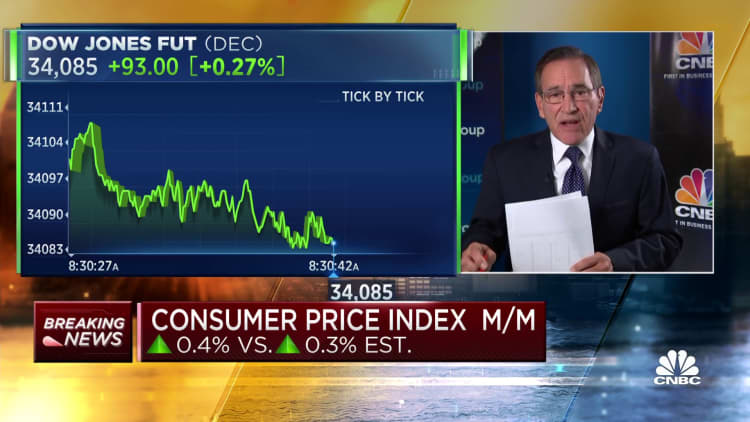Consumer prices rose 0.4%, more than expected

Prices that consumers pay for a wide variety of goods and services increased at a slightly faster-than-expected pace in September, keeping inflation in the spotlight for policymakers.
The consumer price index, a closely followed inflation gauge, increased 0.4% on the month and 3.7% from a year ago, according to a Labor Department report Thursday. That compared with respective Dow Jones estimates of 0.3% and 3.6%. Headline inflation increased 0.6% in August.
Excluding volatile food and energy prices, the so-called core CPI increased 0.3% on the month and 4.1% on a 12-month basis, both exactly in line with expectations. Policymakers place more weight on the core numbers as they tend to be better predictors of long-term trends. Core inflation also increased 0.3% in August, when it was up 4.3% from the previous 12 months.
In keeping with recent trends, shelter costs were the main factor in the inflation increase. The index for shelter, which makes up about one-third of the CPI weighting, accelerated 0.6% for the month and 7.2% from a year ago. On a monthly basis, shelter accounted for more than half the rise in the CPI, the Labor Department said.
Energy costs rose 1.5%, including a 2.1% pickup in gasoline prices and 8.5% in fuel oil, and food was up 0.2% for the third month in a row. On a 12-month basis, food costs climbed 3.7%, including a 6% increase for food away from home, while energy costs were off 0.5%.
Services prices, considered a key for the longer-run direction for inflation, also posted a 0.6% gain excluding energy services, and were up 5.7% on a 12-month basis. Vehicle prices were mixed, with new vehicles up 0.3% and used down 2.5%. Used vehicle prices, a big driver of inflation in the early days of the Covid pandemic, were down 8% from a year ago.
Among the major CPI components, the other main decliners were apparel (-0.8%) and medical care commodities (-0.3%). Medical care services increased 0.3% on the month but were down 2.6% on an annual basis.
Markets showed only a modest reaction to the report. Stocks edged higher at the open, while Treasury yields came off previous lows, with longer-duration notes little changed.
The CPI increase meant worker wages fell in real terms.
Real average hourly earnings dropped 0.2% on the month, owing to the difference between the inflation rate and the 0.2% gain in nominal earnings, the Labor Department said in a separate report. On a yearly basis, earnings were up 0.5%.
“Just because the rate of inflation is stable for now doesn’t mean its weight isn’t increasing every month on family budgets,” said Robert Frick, corporate economist with Navy Federal Credit Union. “That shelter and food costs rose particularly is especially painful.”
In other economic news Thursday, the Labor Department reported that initial jobless claims totaled 209,000, unchanged from the previous week and just below the 210,000 estimate.
The CPI report comes with Federal Reserve officials contemplating their next policy moves.
Minutes from the Fed’s September meeting, released Wednesday, reflected divisions within the rate-setting Federal Open Market Committee. The meeting concluded with the committee opting not to raise interest rates, but the summary showed lingering concern about inflation and worries that upside risks remain.
Since then, however, Treasury yields have jumped, at one point hitting 16-year highs.
Multiple Fed officials have said that the increases could negate the need for further policy tightening, and markets now are pricing only a small chance that the central bank votes to hike before the end of the year. Market pricing further indicates that the Fed will shave about 0.75 percentage point off its key borrowing rate before the end of 2024.
Recent days, though, have brought mixed news on where inflation is heading.
The Labor Department said Wednesday that prices at the wholesale level increased 0.5% in September, pushing the 12-month rate to 2.2%, the highest since April and above the Fed’s goal of 2% inflation.
Correction: The Labor Department said Wednesday that prices at the wholesale level increased 0.5% in September. An earlier version misstated the day.
[ad_2]
Source link


